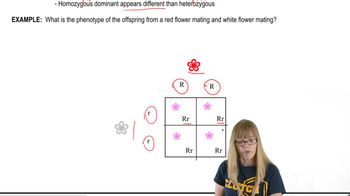Table of contents
- 1. Introduction to Genetics51m
- 2. Mendel's Laws of Inheritance3h 37m
- 3. Extensions to Mendelian Inheritance2h 41m
- 4. Genetic Mapping and Linkage2h 28m
- 5. Genetics of Bacteria and Viruses1h 21m
- 6. Chromosomal Variation1h 48m
- 7. DNA and Chromosome Structure56m
- 8. DNA Replication1h 10m
- 9. Mitosis and Meiosis1h 34m
- 10. Transcription1h 0m
- 11. Translation58m
- 12. Gene Regulation in Prokaryotes1h 19m
- 13. Gene Regulation in Eukaryotes44m
- 14. Genetic Control of Development44m
- 15. Genomes and Genomics1h 50m
- 16. Transposable Elements47m
- 17. Mutation, Repair, and Recombination1h 6m
- 18. Molecular Genetic Tools19m
- 19. Cancer Genetics29m
- 20. Quantitative Genetics1h 26m
- 21. Population Genetics50m
- 22. Evolutionary Genetics29m
3. Extensions to Mendelian Inheritance
Variations of Dominance
Problem 14a
Textbook Question
Textbook QuestionFlower color in snapdragons results from the amount of the pigment anthocyanin in the petals. Red flowers are produced by plants that have full anthocyanin production, and ivory-colored flowers are produced by plants that lack the ability to produce anthocyanin. The allele An1 has full activity in anthocyanin production, and the allele An2 is a null allele. Dr. Ara B. Dopsis, a famous genetic researcher, crosses pure-breeding red snapdragons to pure-breeding ivory snapdragons and produces F₁ progeny plants that have pink flowers. He proposes that this outcome is the result of incomplete dominance, and he crosses the F₁ to test his hypothesis. What phenotypes does Dr. Dopsis predict will be found in the F₂, and in what proportions?
 Verified Solution
Verified SolutionThis video solution was recommended by our tutors as helpful for the problem above
Video duration:
2mPlay a video:
222
views
Was this helpful?
Related Videos
Related Practice

